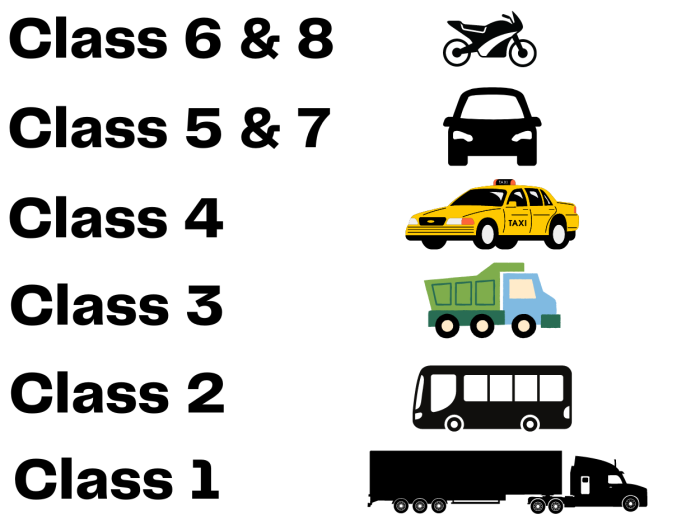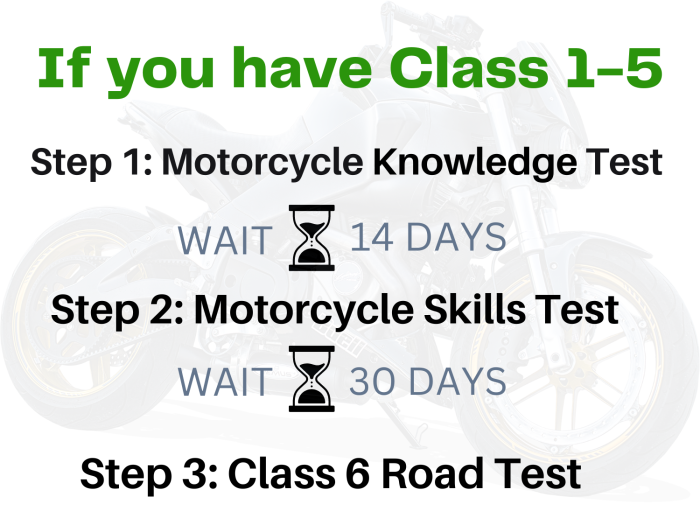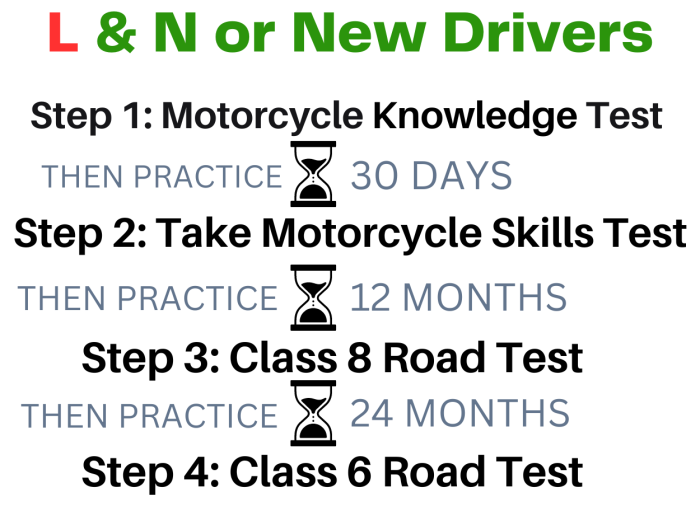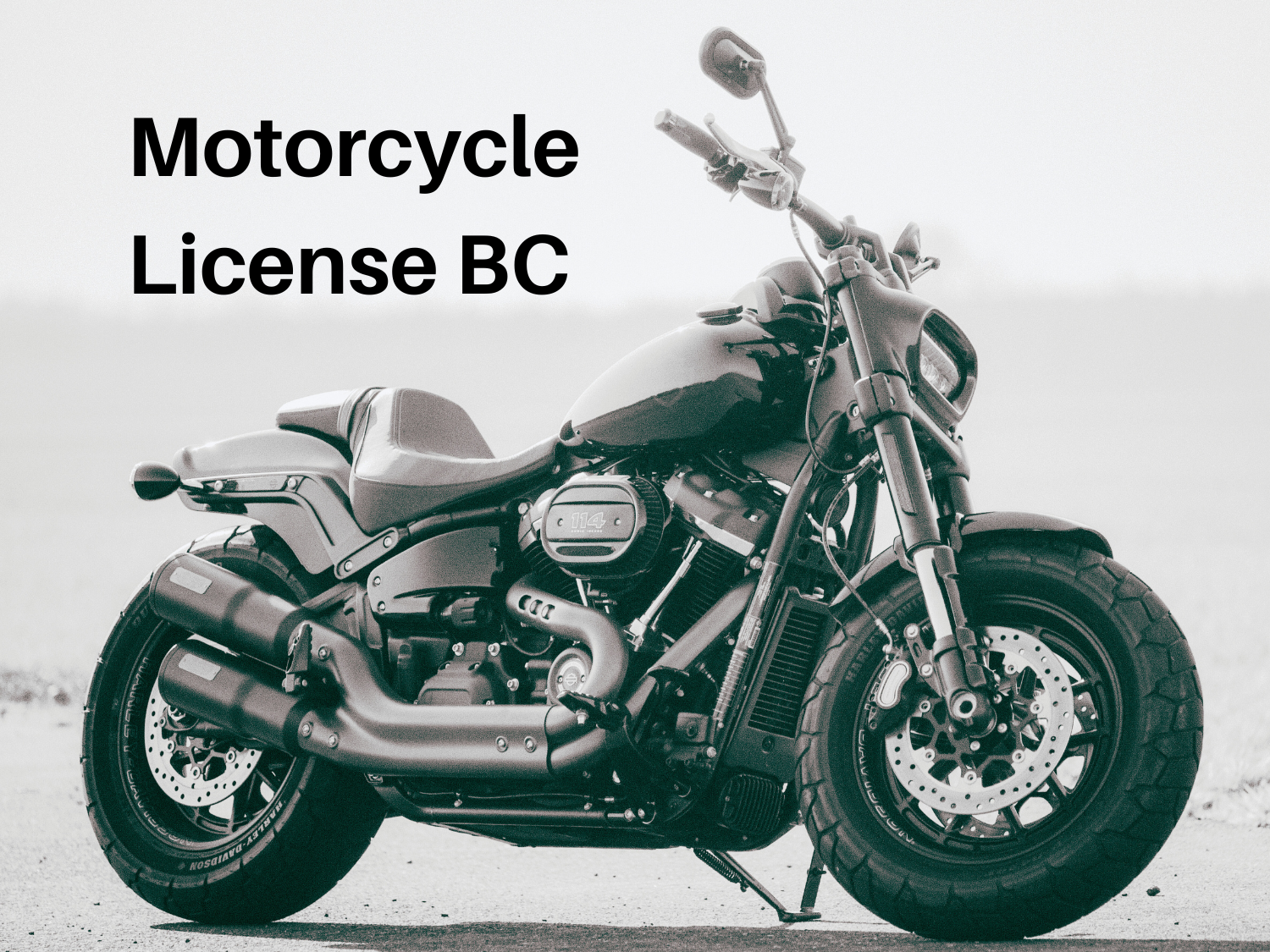There are different steps to getting your motorcycle license in BC, (beautiful British Columbia), depending on if you already have a BC driver’s license or not.

Drivers with Existing BC Licenses
Here are the steps to getting your motorcycle license in BC if you already have a full-privilege BC driver’s license; Class 1, 2, 3, 4, or 5.
Get ready
- Use the Tuning Up for Riders guide as a resource for your practices
- Review the Learn to Ride Smart guide

Step 1: Get your motorcycle learner’s license
To get your learner’s license you need to pass the motorcycle knowledge test
- It will be 40 multiple-choice questions on a touch screen kiosk at an ICBC driver licensing office. It usually takes most people about 30 minutes. You can take more time if you need to
- The test is available in English or Arabic, Cantonese (with traditional Chinese writing), Croatian, French, Farsi, Mandarin (with traditional Chinese writing), Punjabi, Russian, Spanish, Vietnamese, and Ukrainian
- If you’re under the age of 19, your parent or a legal guardian must give consent for your application
- You’ll need to book an appointment to take the test at an ICBC driver licensing office
- Be sure to bring the required ID and payment for the test fee ($15 or $10 for Class 7 or 8 photo learners)
- ICBC will ask about any medical conditions and check your vision
Class 6L Motorcycle Learner’s License
After you pass the motorcycle knowledge test and meet all the other requirements, you’ll get a Class 6L motorcycle learner’s license.
Class 6L Motorcycle Learner Restrictions
- When you ride, you must be within sight of a qualified supervisor. Your supervisor must be at least 19 years old and must hold a valid Class 6 full-privilege license.
- Your speed must not exceed 60 km/hr
- No passengers allowed
- You may only ride in daylight hours; between sunrise and sunset
Step 2: Pass the motorcycle skills test
After at least 14 days with your motorcycle learners, you can take the motorcycle skills test.
- The motorcycle skills test is a 15-minute test of basic riding skills like signaling, handling the clutch and throttle, braking, and turning
- If you don’t pass, you can take the test again after 7 days
- The motorcycle skills test is FREE
You’ll be riding in a paved lot at slow speeds. You’ll need to show that you can:
- Identify the controls on your motorcycle
- Push the motorcycle (non-powered)
- Demonstrate using hand signals
- Use the side stand or center stand
- Ride slowly and straight while using the clutch
- Slalom
- Brake
- Turn, including u-turns,three-point turns, and right turns when moving
- Accelerate and decelerate (this may include shifting gears), and
- Stop suddenly in a controlled manner
As you ride, the examiner watches:
- How you handle the clutch, throttle, and brake controls
- How you shift gears
- Whether you keep your feet on the pegs, and
- Whether you miss any turns or hit any traffic cones.
If you take certified motorcycle training and qualify there is no waiting period and the motorcycle skills test is included.
After you pass the motorcycle skills test
Once you pass the skills test:
- The 60 km/h speed restriction is removed
- You can ride without a supervisor
- Once you have reached your earliest exam date you can take a Class 6 road test
- All other learner’s restrictions are still in effect (sunrise to sunset only, no passengers)
- Be sure to keep track of the time left on your learner license to complete the road tests
- If your learner expires you will be required to re-take both the knowledge test and motorcycle skills test
Step 3: Get your full motorcycle license
After at least 30 days of being a learner, you can get your full license by passing the class 6 road test.
L & N Drivers or New Drivers
Drivers with less than two year’s driving experience have some extra steps in getting their motorcycle license in BC.
Get ready
- Use the Tuning Up for Riders guide as a resource for your practices
- Review the Learn to Ride Smart guide

Step 1: Get your motorcycle learner’s license
To get your motorcycle learner’s license:
- Pass the motorcycle knowledge test
- If you don’t have your L or N, you’ll also have to pass the passenger-vehicle knowledge test
- Your parent or a legal guardian must give consent for your application if you’re under 19
- You’ll have to book an appointment to take the test at an ICBC driver licensing office
- Bring the required ID and payment for the test fee ($15 or $10 for Class 7 or 8 photo learners)
- ICBC will ask about any medical conditions and check your vision
After you pass the motorcycle knowledge test and meet all the other requirements, you’ll get a Class 8L motorcycle learner’s license.
Class 8L Motorcycle Learner Restrictions
- When you ride, you must be within sight of a qualified supervisor. Your supervisor must be at least 25 years old and must hold a valid Class 6 full-privilege license.
- Your speed must not exceed 60 km/hr
- No passengers allowed
- You may only ride in daylight hours; between sunrise and sunset
- You must display an official “L” sign
Step 2: Pass the motorcycle skills test
After at least 30 days with your L, you can take the motorcycle skills test.
- The motorcycle skills test is a 15-minute test of basic riding skills like signaling, handling the clutch and throttle, braking, and turning
- If you don’t pass, you can take the test again after 7 days
- The motorcycle skills test is FREE
You’ll be riding in a paved lot at slow speeds. You’ll need to show that you can:
- Identify the controls on your motorcycle
- Push the motorcycle (non-powered)
- Demonstrate using hand signals
- Use the side stand or center stand
- Ride slowly and straight while using the clutch
- Slalom
- Brake
- Turn, including u-turns,three-point turns, and right turns when moving
- Accelerate and decelerate (this may include shifting gears), and
- Stop suddenly in a controlled manner
As you ride, the examiner watches:
- How you handle the clutch, throttle, and brake controls
- How you shift gears
- Whether you keep your feet on the pegs, and
- Whether you miss any turns or hit any traffic cones
If you take certified motorcycle training and qualify there is no waiting period and the motorcycle skills test is included.
After you pass the motorcycle skills test
Once you pass the skills test:
- The 60 km/h speed restriction is removed
- You can ride without a supervisor
- Once you have reached your earliest exam date you can take a Class 8 road test
- All other learner’s restrictions are still in effect (sunrise to sunset only, no passengers, display official “L” sign)
- Be sure to keep track of the time left on your learner license to complete the road tests
- If your learner expires you will be required to re-take both the knowledge test and motorcycle skills test
Step 3: Pass the Class 8 motorcycle road test
After passing the motorcycle skills test and having your L for at least 12 months, you can take the Class 8 motorcycle road test.
When you pass the Class 8 road test, you enter the Novice stage.
Step 4: Get your full motorcycle license in BC
After at least 24 months with your N, you can take the final test-the Class 6 motorcycle road test. If you also have a passenger vehicle 7N license you only need to complete one road test to exit the GLP (Graduated Licensing Program).
Motorcycle Helmet Laws BC
BC law requires motorcycle operators (and their passengers) to wear an approved helmet. Operators must make sure that all passengers who are younger than 16 wear an approved helmet.
These helmet laws also apply to limited-speed motorcycles. Exception: people of the Sikh religion with unshorn hair who wear full turbans.
Failure to meet these requirements may result in a fine and seizure of any non-compliant helmet. Failure to produce a helmet for inspection is also an offense.
Approved Motorcycle Helmets in BC
A motorcycle safety helmet in BC needs to meet one of the following safety standards:
- DOT: conformance with Federal Motor Vehicle Safety Standard No. 218; Motorcycle helmets (United States of America), also known as FMVSS 218 (49CFR571.218)
- Snell M2005 or Snell M2010: certification in accordance with the Snell Memorial Foundation 2005 or 2010 Standard for Protective Headgear for Use with Motorcycles and Other Motorized Vehicles
- ECE: approved in accordance with the United Nations Economic Commission for Europe (ECE) ECE Regulation No. 22
Your motorcycle helmet must display the proper label—DOT, Snell and ECE helmet standards each contain specific labeling requirements.
Checklist for buying a helmet
- Choose a helmet that meets DOT, Snell or ECE safety standards
- Make sure it displays the proper label and meets the official safety-helmet labeling requirements
- A full-face helmet provides the best protection in a collision; also protection from wind, dust, rain, insects, and debris. It is the only type of helmet that protects your face
- Choose a bright color and be seen (white makes you much more visible)
- Add reflective tape to the sides and back of your helmet for greater visibility
- Your helmet should feel snug around the entire head. You can wear it for 10 to 15 minutes inside the store to make sure no pressure points develop (these can cause headaches while riding) The padding may compress over time and the fit may become looser
- The helmet chin strap is important and keeps the helmet on your head if you’re in a collision. Check the chin strap mechanism and make sure it’s easy to fasten, release and adjust. Make sure it can be fastened securely
- Avoid used helmets. They may have been in a crash and the damage isn’t always obvious
- If you already own a helmet, you should replace if it has been dropped, in a crash, or showing any signs of wear
Frequently Asked Questions (FAQs)
What CC requires a motorcycle license in BC?
What CC requires a motorcycle license in BC? Good question. You will require a Class 5 regular car license for any scooter that is 49.9 CC (50 CC). Any motorcycle larger than 50 CC will require a BC Class 6 motorcycle license.
What license do you need to ride a motorcycle in BC?
In British Columbia, you’ll need a Class 6 License to ride a motorcycle (also for any scooter 51cc or bigger). You’ll need to get a Learner’s License by passing a knowledge test from ICBC before you can start the process of learning how to ride. There are different processes depending on whether you already hold a full-privilege license (Class 1-5) or are a new or learner driver in the Graduated Licensing Program.
How long does it take to get a motorcycle license in BC?
Drivers who already hold a full-privilege driver’s license could get their Class 6 motorcycle license in as quickly as 45 days, or 30 days if they attend a certified motorcycle training course. For new or learner drivers in the Graduated Licensing Program, the process will take three years, but riders can ride without supervision (including several restrictions) in the Novice Stage after passing the first road test.
Can I ride a motorcycle with a Class 5 in BC?
You can’t ride a motorcycle with only a Class 5 license in BC, but if you have a Class 5 or better full-privileged license, you can simply pass the motorcycle knowledge test to receive your motorcycle learner’s license to start riding with a few restrictions.
What is a Limited-Speed Motorcycle? Mopeds & Scooters
“Limited-speed motorcycle” definition (Mopeds and Scooters)
- The motor is equipped with a piston displacement of no more than 50 cc, or a power source that produces a maximum of 1.5 kW
- It does not require clutching or shifting after the drive system is engaged
- It has a maximum speed on level ground of 70 km/h
- It has a maximum weight of 95 kilograms, excluding fuel, and batteries
- It must have wheels with a diameter of 254 mm or more
What are the Rules for Mopeds & Scooters?
Mopeds and scooters must be registered, licensed, and insured for use on the roads.
You can ride one if you have a full-privilege Class 5 or 7-passenger vehicle license (except a learner’s license). A motorcycle license is not required. But, you have to always wear a helmet. You’re also subject to the same rights and duties as drivers of regular vehicles.
